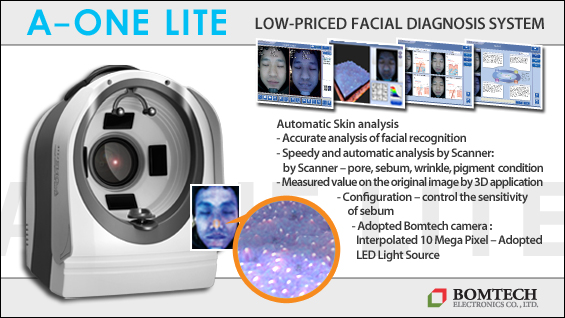▶ Previous Artlcle : #11-2. Development of Hair Removal Lasers III
As mentioned in the previous article dealing with ablative lasers, deep peeling entails a long-term interruption to daily life. However, it is very effective in removing wrinkles and aging signs among Caucasians and removing a certain amount of scars and wrinkles among AsiansAs this therapy causes discomfortand is as invasive as a surgical method, the perioperative processis burdensome for both doctors and patients. In addition, more patients preferred comfortness to superior efficacy in 2000s, doctors and laser manufacturers were in need of a breakthrough.
[Advertisement] A-One LITE(Facial Diagnosys System) – Manufacturer: BOMTECH(www.bomtech.net)
Ablative methods were popular until the late 1990s based on the idea that the skin would improve by regenerating after a non-scarring resurfacing procedure. However, after seeing that skin elasticity and wrinkles were more improved for more than six months after the procedure, people began to realize the importance of stimulating dermal fibroblasts for facilitating collagen regeneration and remodelling. As a result, an innovative laser that irradiates at 1320nm and estimates the dermal temperature by measuring the skin surface temperature was introduced. It was expected to meet the needs of doctors as well as laser manufacturers and patients. This was an ideal laser in theory with no damage to the skin surface, no interruption to daily life, and dermal stimulation producing a reversible damage zone. This laser was released in the name of CoolTouch (CoolTouch Inc.) and was quite successful in terms of sales figures, but unfortunately, the success could not last due to unfavorable clinical evaluations.
Despite certain shortcomings, the market success of CoolTouch was a significant event that shaped the future development of new devices by manufacturers who suffered from rapidly falling demand of laser resurfacing. Not many people would want to receive a therapy that requires a long downtime and leaves redness for half a year, however effective it may be. With few new patients, the sales of expensive ablative lasers was declining slowly in the market. The success of CoolTouch provided a good guideline for other laser manufacturers and researchers on how to overcome stagnation. In the early days, even experts like Rox Anderson publicly questioned the efficacy of the nonablative method. However, with the introduction of the terms nonablative resurfacing’ and ‘subsurface resurfacing’, a number of other lasers with better efficacy were developedDevices utilizing ultrasound and RF soon followed and started taking the lead in skin care treatments. In line with these previous devices, various other lasers with fractional photothermolysis were developed, further highlighting the significance of CoolTouch.
The Advent of IPL
Apart from the development of lasers, Intense Pulsed Light (IPL) called PhotoDerm (Esc Medical System), which uses Xenon arc, was released in the mid 1990s. At first, the devices were divided into PhotoDerm PL (pigmented lesion), PhotoDerm VL (vascular lesion) and PhotoDerm HR (hair removal) using a filter according to their wavelength bands selected from the multiple wavelengths available. However, their efficacy for each indication was inferior to other lasers that used a single wavelength. As it failed to live up to the efficacy expected in the early phase of the development, doctors turned away from this device, except one, Dr. Bitter in the US. Dr. Bitter successfully improved facial blemish, lentigo, vasodilation, general skin tone and elasticity with less downtime using IPL. He named this new procedure ‘photofacial’ (registered term by Lumenis) or ‘photorejuvenation’ and openend a new chapter for IPL treatment (Bitter PH. Noninvasive rejuvenation of photodamaged skin using serial, full-face intense pulsed light treatments. Dermatol Surg. 2000, 26(9):835~42).
The popularity of IPL has slowly increased in Korea as well since the introduction of Quantum (Lumenis) in 2000. Although it may not be as effective as laser for individual indication, the benefit of IPL is that it can improve multiple skin problems at once with a short downtime. With relatively lower production cost than laser and different types of filters available for one device, new IPLs had the relative advantage over PhotoDerm in terms of purchasing cost. In the early 2000s, consumers wanted a therapy that caused less interruption in daily life and companies and doctors tried to live up to such expectations. In this light, IPL started getting a great deal of attention from the public as a treatment that can deliver therapeutic effect with less discomfort. Such a trend was also reflected in development of lasers that were designed to improve wrinkles and skin elasticity, rather than provide deep resurfacing. In the mid 2000s, when the marginal effect was not deemed satisfactory by many people, the intensity of the procedure was slightly increased to accompany swelling, redness and pain. As a result, now the procedural intensity ranges from that with no pain and no interruption in daily life to that with a slight pain and a day or two of downtime, and to the high intensity level with great effect causing pain and crusting.
-To be continued-
▶ Next Artlcle : #12-2. Revival of IPL and Advent of Radiofrequency and Fractional Photothermolysis





















